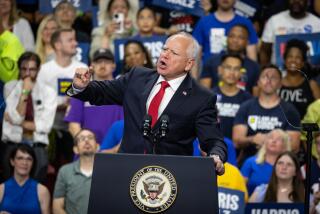McCain’s attack on vets
MORE THAN a few people have been puzzled by Sen. John McCain’s dogged opposition to the updated GI Bill of Rights now before Congress. The dissonance between McCain’s military-man image and his actions on this issue have introduced a jarring note to his presidential aspirations -- and have highlighted the shoddy treatment many Iraq war veterans have received.
Why would a Vietnam War veteran and former prisoner of war, a man who is personally acquainted with the difficulties vets can face in returning to civilian life, join President Bush in opposing a popular bipartisan bill to support the troops? Isn’t fixing the education benefit in the bill -- one that has shortchanged far too many veterans for years -- a political no-brainer in an election year? The 75 senators who recently voted for it certainly thought so. Over the Memorial Day weekend, Sen. Barack Obama expressed some well-timed astonishment at McCain’s opposition, and the two have been feuding about it ever since. The media and pundits seem perplexed, collectively suggesting: That’s not the John McCain we know.
Which is true: It is the John McCain they don’t know. If the media weren’t so mesmerized by the McCain image they have long promoted and instead got to know the McCain record, they would realize that there is nothing surprising or inconsistent about his position on the GI Bill. For years he has opposed legislation that veterans and their advocates deem vital. In doing so, he is simply being true to the contemporary conservative wing of the GOP and its leader, George W. Bush, in opposing social programs and benefits for individuals, even if those individuals happen to be veterans. The only surprise is that anyone finds this surprising.
This time, though, McCain is swimming against the tide of history. The original GI Bill -- signed into law in 1944 -- was one of the most important laws every adopted by Congress. It transformed the nation after World War II in epic fashion, with generous college benefits, stipends, subsidized mortgages, business loans and job training and placement.
Veterans got free rides to any college that would accept them. Tuition, books, housing and living expenses were all covered, giving rise to a new generation of scientists, inventors, teachers, doctors, civic leaders and artists. Low-interest, no-money-down home loans backed by the government made it cheaper to buy than to rent. Suburbia, widespread homeownership, college as a majority aspiration, the middle class -- all were built on the back of the GI Bill.
It reinvented the American dream. Bob Dole and George McGovern went to school on the GI Bill. So did Clint Eastwood and Paul Newman. So did 14 Nobel Prize winners. So did 7 million other World War II veterans.
Today’s GI Bill, however, is a pale shadow of the original, particularly when it comes to college, as Congress has not kept the benefits in line with the rising cost of higher education. The World War II-era living stipend is gone; in its place, members of the military must agree to a $100 monthly payroll deduction to receive the college aid. An education benefit that sent WWII vets to Yale now won’t cover four years at the average public university, though many recruits don’t understand this when they sign up.
Sen. James Webb (D-Va.), a former Marine who served in Vietnam and who was President Reagan’s Navy secretary, has made restoring the GI Bill education benefits one of his signature issues; it was his bill, co-sponsored by Sen. Chuck Hagel (R-Neb.), that cleared the Senate over McCain’s and Bush’s opposition.
McCain argues that making the education benefits too generous will hurt retention, as enlistees will leave for college after three years rather than reenlist. McCain’s position makes sense only by overlooking the fact that the main retention (and recruiting) problems facing the military are the Iraq war and the scandals plaguing military and veterans healthcare. (The most recent outrage: In a Memorial Day speech, Secretary of Veterans Affairs James Peake downplayed the seriousness of brain trauma suffered by tens of thousands of servicemen in Iraq and Afghanistan, calling many of their diagnoses “overblown” and likening them to youth football injuries.)
--
The inadequacy of the military’s prime recruiting tool -- subsidized college educations -- is hurting recruitment too, and Webb argues this can be fixed only by fixing the GI Bill. He says McCain, a friend, “is missing the boat” by siding with the Bush Pentagon rather than veterans groups. Webb points to a Congressional Budget Office analysis that found any possible losses in retention caused by his bill would be balanced by the increases in recruitment it would generate.
McCain’s rationalization for opposing the bill may not hold water, but his stance makes perfect sense in light of his record. From 2004 to 2006, the Disabled Veterans of America gave him annual scores ranging from 50% to the most recent 20% when it comes to supporting the group’s legislative priorities. The Iraq and Afghanistan Veterans of America gave him a grade of “D” in its most recent analysis of voting records. The American Legion says he is dead wrong on the GI Bill, as does the Veterans of Foreign Wars.
When Obama (who has averaged an 86% rating from the Disabled Veterans of America) criticized McCain on the GI Bill, the Arizona senator angrily suggested that Obama’s status as a non-veteran rendered his opinions on military matters worthless (an odd stance, as this standard would also discount the opinions of 85% of American men, 98.8% of American women and two-thirds of Congress). Then he invited a look at his own record by asserting, “I take a back seat to no one in my affection, respect and devotion to veterans.”
So let’s take McCain up on his invitation. Here is how he has stood on recent legislation supported by major veterans organizations:
* On Webb’s GI Bill, he expressed opposition, and he was AWOL when it was time to vote on May 22.
* Last September, he voted against another Webb bill that would have mandated adequate rest for troops between combat deployments.
* On a badly needed $1.5-billion increase for veterans medical services for fiscal year 2007 -- to be funded through closing corporate tax loopholes -- he voted no. He also voted against establishing a trust fund to bolster under-budgeted veterans hospitals.
* In May 2006, he voted against a $20-billion allotment for expanding swamped veterans medical facilities.
* In April 2006, he was one of 13 Senate Republicans who voted against an amendment to provide $430 million for veterans outpatient care.
* In March 2004, he voted against and helped defeat on a party-line vote a $1.8-billion reserve for veterans medical care, also funded by closing tax loopholes.
Before the Senate voted on Webb’s GI legislation, McCain offered what he called a compromise bill, but it was rejected. Webb pointed out that there really was no compromise in McCain’s proposal because it would have excluded most veterans by offering full education benefits only to those with multiple enlistments, even though 70% to 75% of enlistees leave after one tour.
Compare McCain’s stingy standards with the original GI Bill: Any veteran who served 90 days during World War II, in combat or not, earned full benefits. It is Webb’s bill that represents the reasonable compromise between the gold standard set for the “greatest generation’s” original GI benefits and what is doable in today’s economy: a GI Bill that will truly pay for a college education after three years of service, without the onerous payroll deduction.
So here is where the McCain image and reality part company. It is certainly true that his affectionate and respectful rhetoric for America’s servicemen and women takes a back seat to no one. But when it comes to improving the health and education of our veterans, McCain’s record leaves them stranded by the side of the road.
More to Read
Get the L.A. Times Politics newsletter
Deeply reported insights into legislation, politics and policy from Sacramento, Washington and beyond. In your inbox three times per week.
You may occasionally receive promotional content from the Los Angeles Times.










